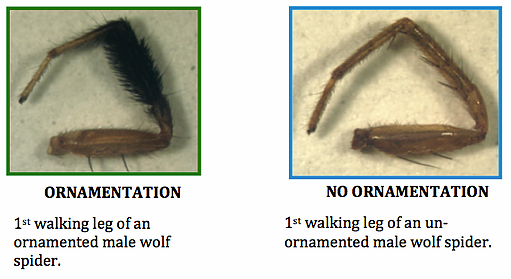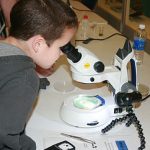Community Experiment
GOAL: The goal of this station is to engage the participants in a hands-on foraging experiment that allows them to:
-
Learn how to eye-shine for wolf spiders
-
Catch their own spider
-
Conduct a portion of an actual experiment
-
Enter data into a spreadsheet
-
Watch the results real-time
-
Think about the evolution of sensory systems and associated communication.
OVERVIEW OF EXPERIMENT: You will need a darkened room with soil-filled plastic tubs scattered throughout. In each tub, place ~30 juvenile wolf spiders (these are very common throughout North America and can be collected easy at night during the warmer months using eye-shines to locate individual spiders). Participants are given a head-lamp, vial (pre-labeled with a green or blue sticker), and clipboard with background information, experimental instructions and data sheet, and a pencil. They are guided into the darkened room and shown how to use eye-shines to find wolf spiders. They are introduced to the fact that spiders, like many nocturnal mammals, have a retina (a light reflecting layer) that aids in night vision. Each participant will use their vial to collect their own spider.
Upon exiting the darkened room with their spider, participants will be guided to their appropriate station based upon their treatment group. Their collecting vial should already have a colored sticker on the lid, which informs them of their experimental treatment group (blue = granite/vibrations absent; green = filter paper/vibrations present). Stations for each treatment should already be set up. Upon arriving at their assigned station, participants follow the instructions on their data sheet.

After completing their experiment (see below), they enter their data into a computer which is hooked up to 2 monitors – the second of which has a data graph where they can watch the graph change in real-time as data are entered. The background material, hypothesis, and can be found on the following pages:
MATERIALS:
-
A dark room in which plastic tubs filled with potting soil, moss, and live wolf spiders can be placed. If this activity is done during warmer months, participants can go outside at night to collect their own spider.
-
Snap cap plastic vials pre-labeled with green or blue small stickers representing the experimental treatments.
-
Head-lamps.
-
Clipboards with instructions and a pencil attached.
-
Stations set up with the following:
-
Plastic enclosures with no bottoms that can placed upon either (i) a piece of white granite, or (ii) a piece of white filter paper. These correspond to the blue dots on the collecting vials.
-
A container full of crickets (mealworms or some other prey items could probably be substituted).
-
Soft forceps for transferring the prey item.
-
A stop watch.
-
Squirt bottle of alcohol and cotton swaps for cleaning containers.
-
Fresh filter paper for green stations.
-
-
A computer set up with 2 monitors. An excel file should already be started with appropriate columns in which participants can readily sit down and enter their data. The program should be set up such that a graph is generated real-time on an adjacent monitor.


EXPERIMENTAL QUESTIONS:
HOW do spiders communicate with one another and WHY would they need to communicate?
WHAT sensory channel(s) do they use for communication?
-
vision (sight)
-
audition (sound/vibrations)
-
chemical (smell/taste)
-
mechanical (touch)
WHY might closely related species use different sensory channels for communicating?
WHAT factors could most influence the EVOLUTION of spider communication?
EXPERIMENT BACKGROUND:
Adult males of some wolf spiders SING and DANCE to convince females to mate with them. They have either ornamented or unornamented front legs (see images below). Ornamented males wave, arch, and tap their fancy legs during their courtship dances (visit the Spider Dance Disco to see this in action). Males with No Ornamentation tend to have less active courtship displays; but ALL males “sing”.

LISTEN to the songs of wolf spiders (visit the Sound Station if you haven’t already). All Schizocosa wolf spiders SING to their potential mates. They have different ways to produce VIBRATIONS that travel through the surface of leaves, grass, twigs, pine needles, or any other surface on which they might court.
WHY do some species use VISUAL and VIBRATORY courtship displays to impress females while others use only VIBRATORY displays?
WHAT sensory system do wolf spiders rely upon most for foraging or detecting prey?
The photo on the left shows all eight EYES on a wolf spider face.
The photos below show the LYRIFORM ORGANSthat spiders use to detect vibrations.

Imagine that one species uses VIBRATIONS for detecting prey while another species relies more on VISION.
The reliance on different sensory systems in one context – like foraging – could influence the evolution of sensory systems used in another context – like courtship signaling.
If true, we predict that species that use primarily vibrations for prey detection have courtship displays made up of primarily vibratory signals.
Together, let’s TEST this idea using the wolf spider Schizocosa floridana, which we already know relies predominantly on vibratory signals during courtship!!
HYPOTHESIS – An unornamented wolf spider, Schizocosa floridana, which we relies predominantly on vibrations for courtship, also relies heavily on vibrations for foraging.
PREDICTION – Spiders will take longer to attack prey in the absence versus presence of vibratory cues.
GENERAL PROTOCOL – Together, we will record the time it takes spiders to attack crickets on two different substrate types: (i) granite, which cannot transmit cricket vibrations, and (ii) filter paper, which transmits cricket vibrations well.
PROCEDURE:
STEP 1. Collect your spider
-
Put on your headlamp, grab a collecting vial and LEARN how to find spiders from the reflection of their eyes. Catch a spider!
STEP 2. Determine your experimental treatment
-
LOOK at the colored sticker on your collecting vial:
-
BLUE = granite substrate (NO Vibrations/Visual only – vibrations associated with the cricket’s movements are unable to transmit through granite).
-
-
GREEN = filter paper substrate (Vibration + Visual).
-
Locate an appropriate and available experimental arena.
STEP 3. Release your spider
-
RELEASE your spider into the arena and start your stopwatch (this will be your practice for using your stopwatch). Let the spider get used to the new environment for at least 2 minutes.
-
During this ‘acclimation’ period for the spider, turn over this sheet and fill in the top information.
-
After 2 minutes, PLACE the vial gently over the spider to contain it.
STEP 4. Collect your prey item
-
GRAB a single cricket from the container using the forceps provided & PLACE the cricket in your arena.
STEP 5. Observe foraging behavior
-
Practice using your stopwatch. Once you feel comfortable, lift the vial off the spider to release it and immediately START the stopwatch!
-
STOP the stopwatch as soon as the spider attacks the cricket. RECORD your time to attack on the sheet below. Observe for as long as you like.
STEP 6. Collect your spider and Clean your arena
-
COLLECT your spider back into your collecting vial & return it to a volunteer.
-
If relevant, remove your filter paper from your arena.
-
GRAB a squirt bottle of alcohol and squirt a little onto a cotton ball. Use the cotton ball to wipe down the edges and bottom of the arena thoroughly.
STEP 7. Enter your data in the computer!!!

Results!
Use the links below to see the results of previous community experiments.


